The History of Garces Memorial High School
Garces Memorial High School traces its origins back to the earliest days of Catholic education in Kern County. In 1910, the Sisters of Mercy founded St. Francis Elementary School in the basement of St. Francis Church, located on Truxtun Avenue. In 1926, a new two-story school building was built next to the convent.
As the years passed and the school grew, Pastor Leo Beacom and the Sisters began to make plans to add a high school that would utilize the vacant second floor of the school building.
St. Francis High School
In September 1940, the Sisters of Mercy added a ninth grade. Eight girls made up the first Freshman class; all of their classes were taught by two of the Sisters. In 1941, a tenth grade was added to accommodate these students and a new freshman class enrolled, again consisting of all girls. In 1942, an eleventh grade was added and the first boys enrolled in St. Francis High School.
In September 1943, the Dominican Sisters’ Congregation of St. Thomas Aquinas replaced the Sisters of Mercy as administrators of the school, which now had a record enrollment of forty girls and ten boys.
The 1943-44 school year was an important and exciting year in the school’s history, marked by a pioneering spirit. The addition of a senior class meant the start of a full functioning high school and generated tremendous excitement. Students made their first strides in competitive athletics and mounted a successful comedy production. A new science lab was outfitted, adding biology to the curriculum, a business department was started with a class in typewriting, and there were several student body dances.
The year culminated in the spring of 1944 with graduation week. The week’s activities included the Junior-Senior Prom, followed by the Junior-Senior Banquet, Baccalaureate, Class Day, and Graduation exercises for the eight seniors presided over by His Excellency Bishop Philip G. Scher.
The Garces Genesis
In October of 1944, Monsignor Culleton, Chancellor of the Monterey-Fresno Diocese, visited the Sisters of St. Dominic and spoke of the need for a central Catholic high school, serving all of Bakersfield. On April 4, 1945, Bishop Scher conducted an all-parish meeting at St. Francis. It was decided to build and conduct a high school along the lines of San Joaquin Memorial High School in Fresno. The Sisters would teach the girls and the Brothers of the Christian Schools would teach the boys.

Christian Brothers & Dominican Sisters
On June 28, 1945, the Kern County Land Company “sold” a 40-acre plot of land to the diocese of Monterey-Fresno for the sum of five dollars.
During this time, St. Francis High School continued to operate, graduating classes in 1945, 1946 and 1947. In the Fall of 1946, the student body selected the name “Terrors” for their athletic teams. The name enjoyed a brief tenure--just two days later, the teams became the “Shamrocks.”
By 1947, enrollment had reached 125 while the faculty still consisted of only four Sisters.
Garces Memorial High School
In the spring of 1947, ground was broken for a new, 40-acre central Catholic high school located in the northeastern section of the city in a newly created residential area called La Cresta.
On September 7, 1947, the public was invited to an open house for the new Catholic high school. Three days later, on September 10, Garces Memorial High School opened as a co-educational, inter-parochial high school with an enrollment of 150 students. The new school was named for Padre Francisco Garces, a Franciscan missionary and the first European to enter the area known today as Bakersfield.
During the first year, the Christian Brothers were placed in charge of the boys division, teaching grades seven, eight and nine, while planning to add an additional grade each year. The girls division, plus the tenth, eleventh and twelfth grade boys, were taught by the Dominican Sisters. The first faculty was comprised of Brother Xavier, F.S.C., Boys Principal, three other Brothers, Sister M. de Ricci, Girls Principal and three other Sisters. The Sisters continued to commute from the St. Francis Convent until their convent was completed on the Garces campus on February 4, 1948.
The Physical Plant
That first year, the campus bore little resemblance to the one we know today. The physical plant consisted of two classroom units with four rooms in each, an administration building and the Brothers’ residence. The landscape was dominated by large areas of dusty ground and long ditches, containing or awaiting lengths of pipe for a future sprinkler system. Day after day, Monsignor MacLaughlin, chairman of the board and pastor of St. Francis, worked away at the ditches with a shovel and a pick.
By mid-November, ground had been leveled and covered with blacktop for basketball courts. The board of directors, composed of the pastors of the Bakersfield parishes, purchased two Quonset huts. One was used as a lunch room, replacing the lunch stand operated by John Andre, and the other stored athletic equipment.
By early 1948, construction was underway for two more classroom units and a multi-purpose building. In the spring of 1948, a dust storm almost buried the five existing buildings and those under construction. The school dug out and pushed forward. Garces’ first graduating class, consisting of nineteen girls and seven boys, participated in ceremonies conducted June 6 at St. Francis Church. The Christian Brothers held an eighth grade graduation on June 7 in the all-purpose building (the APB).
The APB and classrooms were completed by the end of the summer. It was a good timing--the APB was needed to serve as the church for the newly formed Our Lady of Perpetual Help parish until such time as their church could be built. Extensive landscaping was undertaken and the circle at the front of the campus was competed.
The Young School Gains Momentum
The 1948-49 school year saw a great many firsts for the young school: monthly student body masses and vocational conferences, a fully planned student social calendar including a cultural guest artist series, an all-school play, and the commemorative publication of El Padre which honored the Dominican Sisters on their 60th anniversary on the Pacific Coast. The year also marked the end of the “Shamrocks” and the beginning of the “Garces Rams.”
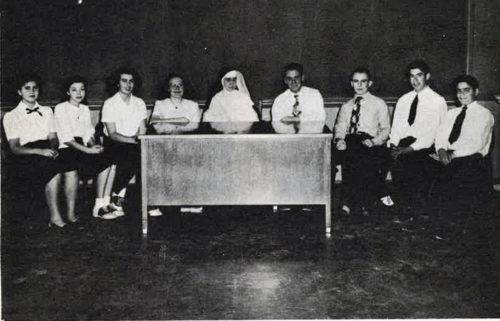
ASB: 1948
The Kern County Historical Society, chaired by Dr. P.N. Root, commissioned John Palo Kangas, a well-known sculptor, to create a statue of Father Garces for the front of the school. On November 27, 1949, the statue was unveiled and dedicated. Sheriff John Loustalot presided as master of ceremonies and County Superintendent of Schools, Jesse D. Stockton was the guest speaker. Dr. Root unveiled the monument and Monsignor William MacLaughlin blessed the statue.
The Christian Brothers’ chapel was dedicated in May 1950. The furnishings were a gift of the Joseph Belluomini family in memory of their daughter Josephine M. Raffetto. During the summer of 1950, another classroom building was completed, making a total of five units and 20 classrooms. The Dominican Sisters’ chapel, a donation of William Howell, was completed in November 1950.
On Sunday, November 19, 1950, the statue of Our Lady of Grace and the grotto were unveiled and dedicated. It was donated by the Guido Martini family with Vincent Marracini donating his services in the construction of the shrine.

The Grotto: 1954
In the 1950-51 school year, the Christian Brothers began teaching all the boys in grades seven through twelve. During the spring of 1951, a large wooden building was purchased from Our Lady of Guadalupe parish and transported to the campus to serve as a cafeteria. The interior was reconstructed and equipment was purchased for the kitchen. Students raised $1,450 from a typewriter raffle to help pay for the furnishings. The building would serve as the Garces cafeteria for the next 33 years.
The Golden Era of Garces
In the 1953 El Padre, 1952-53 is referred to as the “Golden Era of Garces.” Indeed a great deal of construction resulted in a dramatic new look for the campus. By September 1952, the seventh classroom unit was in place and the middle section of the football stadium was completed, enabling the facility to be used for the first time. The stadium was named in honor of Sam Tobias, an active school supporter and Booster Club member, the group that made the stadium possible.
In 1953, lights were added to the finished stadium and the Rams played their first night games. An addition to the Brothers’ residence was constructed to house the growing faculty. Perhaps the greatest change, however, was the brand new gymnasium--a dream come true for Ram supporters.
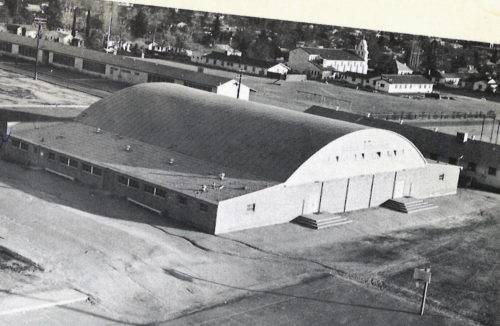
The Gymnasium: 1956
The Fifties and Sixties
Over the next few years, the school saw the addition of a field house and snack bar, a bookstore, a janitor supplies building, and additional restroom facilities. By the summer of 1959, additional areas had been covered with blacktop, including the area now used for student parking. The student population expanded during the 1950s to over 400. Along with this increase in students came an expanded faculty with an increasing proportion of lay staff.
The early 1960s was a time of stabilization at Garces. The enrollment leveled off at a little more than 400 students. The staff numbered 25 including 15 nuns and Brothers. In 1963, the Garces Junior High School for Boys was closed in order to free more Brothers to handle the teaching load required by the growing enrollment in the high school.

School Dance: 1960's
In the mid1960s, enrollment once again began to increase. Shortly after his appointment as school administrator in December 1965, Brother Frederick, F.S.C., announced a ten-year building and modernization program to accommodate this new growth. In October 1966, work began on the plan which called for a new science wing, cafetorium, two eight-room classroom units and a new administration building. The first phase of the building project, completed in the spring of 1967, included an eight-classroom unit with four counseling rooms and a teachers’ lounge, and the removal of the two oldest classroom buildings directly opposite the administration building.
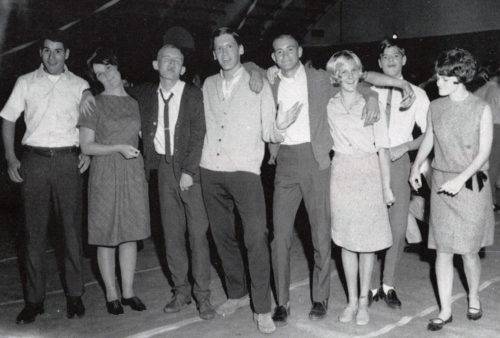
Group Picture: 1964
Garces to Close its Doors?
The school came under the direct supervision of the Fresno Diocesan Office of Education in July 1968. With a growing student body and a plan for the future, things looked bright for the high school.
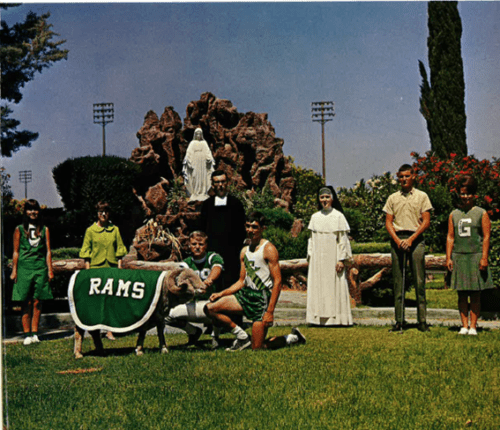
A Group by the Grotto: 1967
But in 1970 a major crisis developed that not only slowed the school’s development, it threatened to close its doors altogether. In February of 1970, the Christian Brothers announced that due to a drastic decrease in vocations to their order they would be compelled to withdraw their members from the Garces staff. Due to the anticipated cost of filling this void with lay staff, it appeared that the diocese would be forced to close the school.
A press conference on the steps of St. Joseph Church was called by the diocese of Monterey-Fresno to announce the school’s closure. As the press release was distributed by a representative from the diocese, a Garces supporter snatched them back with a sharp explanation, “Wait until the truth comes out.”
The truth was that a committee of concerned parents and other members of the Catholic community committed themselves to keeping the school open. A local board of education was formed to deal with issues of finances and staffing.
With the Christian Brothers recalled to teach in schools owned by their own community in June 1970, the 1970-71 school year saw a change in administrative structure. Garces became co-educational with one faculty, one program of studies, and one set of policies for the entire school. The school was administered by the Dominican Sisters until the beginning of the 1978-79 school year when lay administrators began governing the school. Dr. Richard Tucker was hired as principal, a role in which he would serve for the next ten years.
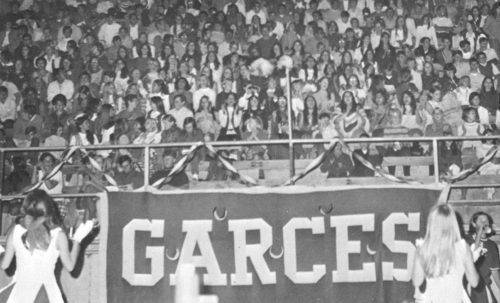
Garces: 1971
The Campus Expands in the Eighties
Dr. Tucker and a dedicated group of parents and supporters created the GARCES GALA in 1980. In its first year the two-day dinner and auction set a county record for fund-raising and by the end of the decade helped finance a further expansion of the campus. The annual event is still one of the school’s biggest fund-raisers, thanks to the continued support of the local community.
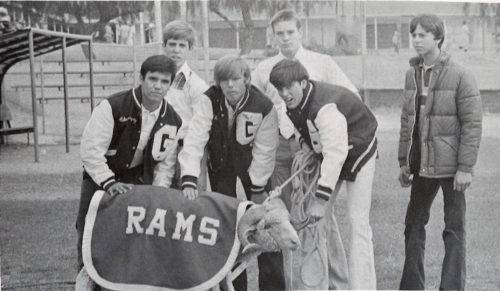
The Ram: 1978
In 1981, the Garces Booster Club built a fieldhouse/weight-room on the southeast corner of Tobias Field and named it after long-time supporter, John Kovacevich, Sr.
In 1984, Monsignor Leddy Hall, named for the former pastor of St. Francis Church who did so much to keep the school in operation, was opened. Daily lunch service moved into the new cafetorium, which also provided a much needed space for school liturgies and assemblies.
In the Fall of 1986, students stepped into a new science building. The facility contained two biology labs, a chemistry lab and a general science room, each stocked with enough equipment to guarantee students plenty of hands-on instruction.
The first interscholastic girls’ sports team at Garces was the 1976 track team. By the early 1980s, the number of girls’ and boys’ teams had grown to the point that nearly two-thirds of the student body was participating annually, a number that still holds true today. In the decades since, Garces student-athletes have accumulated well over one-hundred team Valley Championships and scores more individual titles, ranking Garces fourth all-time in the history of the CIF Central Section.
Administrative Restructuring Furthers Growth
In 1991, the school once again saw several changes in its administrative structure. Edwin J. Hearn was hired as the school’s first president/principal and began working with the board on implementing an organizational restructuring. A business manager and a director of development were hired, several administrative and classified office positions were consolidated, the budgetary process was revamped, and a summer-school session was created.
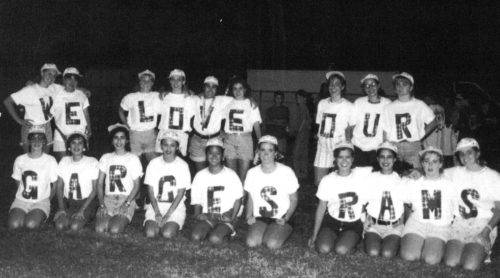
We Love Our Garces Rams: 1993
In early 1995, the Garces Board of Directors and Bishop John Steinbock approved GARCES 2010, a 15-year strategic plan. Crafted by a group of dedicated supporters in consultation with school staff and administrators, the plan laid out a blueprint for the future.
Early projects included refurbishing four classroom wings, remodeling the Brothers’ residence into today’s administration/development center, building a new west-side athletic field and stadium concession stand, and replacing the leaky gymnasium roof. In the Fall of 1997, the old administration building was converted into the current library/technology center. The next year, the old cafeteria became the home of the music and art departments. Shortly after, landscaping and a block G were added to the west field hillside.
The baseball and softball facilities were also renovated, including adding lights. The baseball field was named in honor of David A. Fanucchi, who helped create the first Garces Steak Barbeque in 1963 and then chaired the event for decades. It is still one of the community’s most anticipated annual events and has raised hundreds of thousands of dollars for the school since its inception. The softball field was named in memory of a beloved former chaplain at the school, Father Bernie Brannon, SJ.
Garces in the 21st Century
In 2001, the school’s Rector and Board of Directors voted unanimously to move Garces into the future by splitting the President/Principal role. In 2003, former Garces principal, Dr. Richard Tucker returned to the school to serve as interim President. In July 2004, former Garces vice-principal, Dr. John Ritter returned as interim Principal and Mr. John Fanucchi (class of 1968) was appointed as the school’s new President. Former staff-member, Robert Garcia returned as the new Principal in 2005. Working with the Board of Directors, he and Fanucchi revisited the GARCES 2010 plan, updating priorities and organizing a long-range funding campaign.
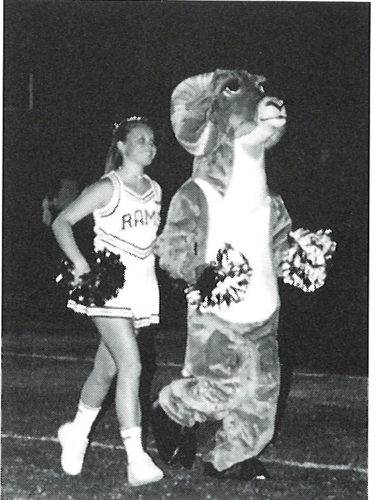
Cheer: 2001
A new entrance was added to Sam Tobias Field in 2002. In 2004, one of the school’s most historic renovations was completed, with the restoration and relocation of the statue of Padre Garces. Dedicated at its original curbside location in 1949, the restored statue was blessed once again when it was unveiled at the front gate of the campus on November 1.
Meanwhile, with the aid of many Garces supporters including the Patricia C. Brown Foundation, Monsignor Leddy Hall and the gymnasium were refurbished and a new fieldhouse/weight-room was built. In 2005, Pat McDermott (class of 1981) spearheaded a project to rebuild the crumbling fifty year-old bleachers at Sam Tobias Field, doubling the stadium’s seating capacity. Tim Sullivan (class of 1973) and the Sullivan Petroleum Co., along with Chevron, donated a new stadium scoreboard.
Preparing for the Future
After the school’s antiquated electrical system was replaced, work began on a new state-of-the-art science facility, which opened in 2008 after being named in honor of school benefactors, Victor and Delores Cerro. The next year, the all-purpose building (with its iconic bell-tower) was converted into the St. Dominic Chapel, thanks to the generosity of Jimmie and Marjorie Icardo and the Salvucci Family. Sadly, Robert Garcia passed away in 2008 before the projects he inspired were completed. Staff veteran, Kathleen Bears was appointed to succeed him as Principal, a role she served for six years. In 2014, Dr. Richard Tucker came back and served as the interim principal for one year. At the end of the 2014-2015 school year, John Fanucchi retired as the president and the school moved back to a head of school administrative model naming Garces faculty member, Mrs. Myka Chambers as the Administrator-Principal of Garces Memorial. Garces transitioned back to the President/Principal model for the 2022-2023 school year with Mr. Kent Hickey as the Transitional President and Myka Chambers as the Principal.
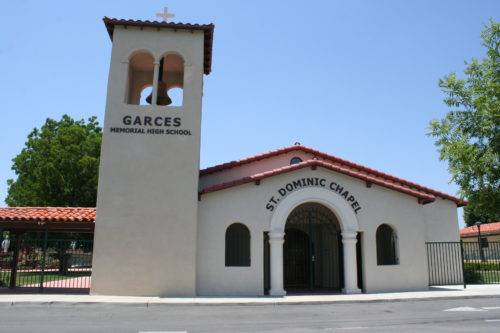
St. Dominic Chapel
Aquatics and tennis have always been among the most popular (and successful) athletic programs at Garces; with the addition of water polo teams in 2008, nearly a quarter of the student body participates annually. But both programs required the year-round rental of expensive off-campus facilities and caused difficulties in transportation, site management and student supervision. The problem was solved once again by the efforts and generosity of the Garces Family, when the Salvucci Aquatics Center, built between the gymnasium and stadium, was opened on January 7, 2011 and eight tennis courts were completed behind the stadium later that summer.

Aquatics Pool
In 2013, the classroom wing opposite the gymnasium was remodeled to accommodate a new student counseling center, replacing a previously used portable building. The campus technology center was also upgraded with Garces Memorial becoming the first school in Kern County to distribute I-Pads to its student body and staff when the 2013-14 school year began. Due to a generous donation from E.G. and Frankie Berchtold, the construction of a new music facility, located west of Monsignor Leddy Hall, was completed and unveiled in April 2014. In 2016, Garces remodeled a classroom into a dance room and shortly thereafter, began the first competitive high school dance team in Kern County. In 2019, Garces added a state-of-the-art Project Lead the Way classroom named after Garces benefactors, Jean and Earl Leach. Future plans include a remodel of Monsignor Leddy Hall, new classroom buildings and a new gymnasium.
The Padre’s Dream Endures
In July 1776, Padre Francisco Garces camped near the present site of the school during his historic trek to spread his Catholic faith. He noted in his journal that it seemed like a good site for a mission. Today’s reality is not far from his dream. Out of 40-acres of barren soil, Garces has grown into one of the finest educational institutions in the Central Valley. Over 95% of its graduates have gone on to higher education, some to national and even international acclaim in their fields. The school stands today as a testament to the good padre’s devotion and vision. Still firmly rooted in his Catholic faith, Garces Memorial High School carries on his mission in the 21stCentury.
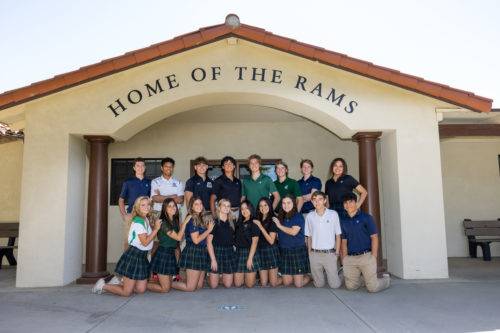
Home of the Rams!



